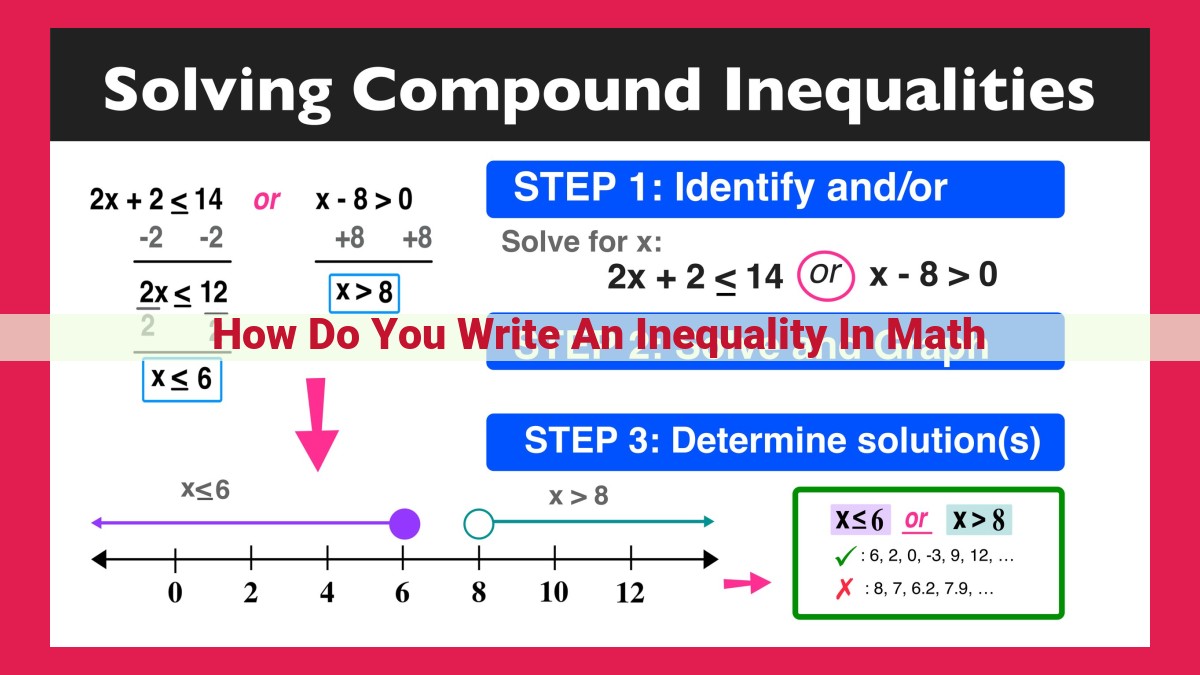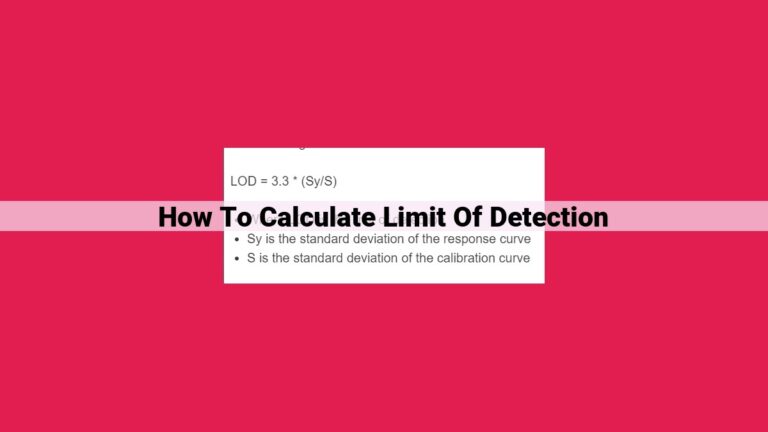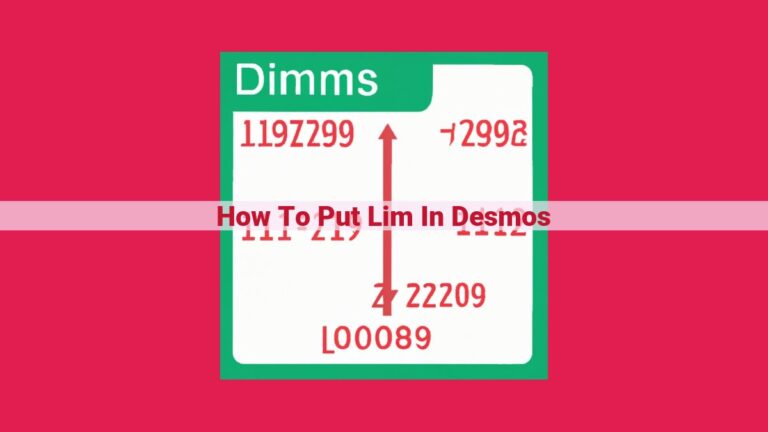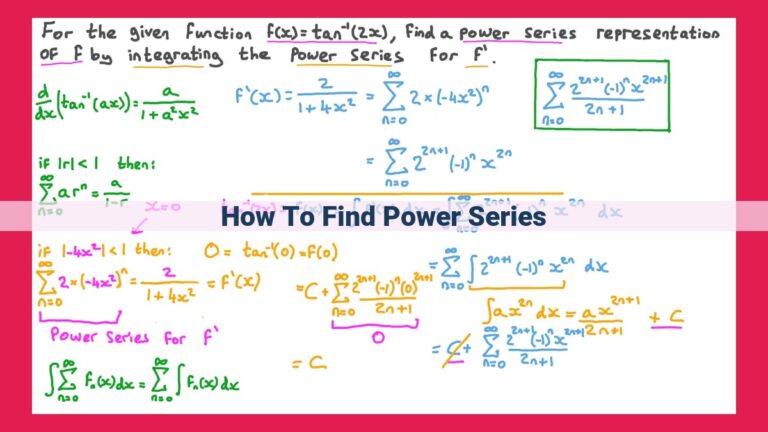Master Inequalities In Mathematics: A Comprehensive Guide To Solve And Graph

Inequalities are mathematical statements that express an unequal relationship between two expressions. They are written using symbols such as > (greater than), < (less than), ≥ (greater than or equal to), ≤ (less than or equal to), and ≠ (not equal to). Inequalities can be solved by finding the values that make the statement true, and can be graphed on a number line. Compound inequalities combine multiple inequalities using “and” or “or,” and specific types of inequalities include absolute value inequalities, quadratic inequalities, and rational inequalities. Writing inequalities involves understanding the symbols and types, as well as practice in solving and graphing them.
Unveiling the Essence of Inequality: A Comprehensive Guide
In the realm of mathematics, inequality stands apart from its counterpart, equality. While equality signifies an exact correspondence between two expressions, inequality conveys a relationship of difference. Quantities can be unequal in magnitude, direction, or proportion, giving rise to a vast array of symbols that define their disparities.
Inequality Symbols: Deciphering the Language of Difference
Inequality is expressed through a distinct set of symbols, each with its own nuanced meaning:
- > (greater than): This symbol indicates that the expression on the left-hand side is larger than the expression on the right-hand side.
- < (less than): In contrast, this symbol denotes that the expression on the left-hand side is smaller than its counterpart on the right.
- ≥ (greater than or equal to): This inclusive symbol conveys that the expression on the left-hand side is either larger than or equal to the expression on the right.
- ≤ (less than or equal to): Similarly, this symbol indicates that the expression on the left-hand side is either smaller than or equal to the expression on the right.
- ≠ (not equal to): This symbol signifies that the two expressions are distinct, with no equivalence between them.
Types of Inequalities: Unveiling the Hidden World of Comparisons
In the realm of mathematics, inequalities play a crucial role in expressing relationships between numbers. Going beyond simple equality, they unveil a vast array of possibilities, allowing us to explore the intricate web of comparisons.
Variations in Inequality Symbols
Inequalities are not limited to a single symbol. Just as we have different ways of expressing equality, such as ‘a = b’ or ‘a equals b,’ inequalities come in various flavors, each with its own unique meaning. The most common inequality symbols include:
- Greater than (>) and Less than (<): These symbols indicate that one number is greater or smaller than another. For example, 5 > 3 means that 5 is greater than 3.
- Greater than or equal to (≥) and Less than or equal to (≤): These symbols allow for equality in addition to inequality. For instance, 5 ≥ 5 means that 5 is greater than or equal to 5.
- Not equal to (≠): This symbol signifies that two numbers are not equal. 2 ≠ 5, for example, clearly states that 2 is not equal to 5.
Solving Inequalities: A Quest for Satisfaction
The ultimate goal in working with inequalities is to find the values that satisfy them. These are the values that make the inequality true when substituted into it. For instance, to solve the inequality 3x – 1 > 5, we need to find all the values of x that make this statement true. We can do this by isolating x on one side of the inequality and simplifying accordingly.
Graphing Inequalities: Visualizing the Comparisons
Inequalities can also be graphically represented on a number line. This allows us to visualize the set of values that satisfy the inequality. For example, the inequality x < 3 can be graphed on a number line as a shaded region to the left of 3. This shaded region represents all the values of x that are less than 3.
Writing Compound Inequalities: Combining “And” and “Or”
In the realm of mathematics, we encounter a fascinating concept known as compound inequalities. These inequalities combine two or more simple inequalities using the words “and” or “or.” Understanding how to write and solve compound inequalities is crucial in expanding our problem-solving skills.
When faced with a compound inequality, it’s essential to discern whether the inequalities are connected by “and” or “or.” Let’s delve into each scenario:
Using “And”: Combining inequalities with “and” indicates that both inequalities must be simultaneously satisfied. In other words, the solution set of the compound inequality consists of the values that satisfy both the individual inequalities.
For instance, consider the compound inequality:
2x – 5 > 1 and x + 3 < 7
To solve this inequality, we need to find the values of x that satisfy both the left-hand inequality (2x – 5 > 1) and the right-hand inequality (x + 3 < 7). By solving each inequality separately, we obtain:
2x > 6 and x < 4
Plotting these inequalities on a number line reveals that the overlap between the two solution sets is the interval (3, 4). Therefore, the solution set of the compound inequality is:
3 < x < 4
Using “Or”: When we connect inequalities with “or,” it implies that the solution set consists of the values that satisfy either the left-hand inequality or the right-hand inequality.
Take this compound inequality:
x – 2 > 5 or x + 1 < 3
In this case, we need to find the values of x that satisfy either the left-hand inequality (x – 2 > 5) or the right-hand inequality (x + 1 < 3). Solving each inequality separately yields:
x > 7 or x < 2
Plotting these inequalities on a number line demonstrates that the solution set of the compound inequality is the union of the two solution sets, which is the interval (-∞, 2) U (7, ∞).
Remember, to solve compound inequalities, always consider the relationship between the inequalities and whether they are connected by “and” or “or.” By breaking down the problem into smaller parts and understanding the individual inequalities, we can effectively determine the solution set for the compound inequality.
Overcoming the Obstacle Course of Specific Inequalities
Welcome to the world of specific inequalities! In this blog post, we’ll venture beyond the realm of regular inequalities and encounter three formidable opponents: absolute value inequalities, quadratic inequalities, and rational inequalities. Each of these mathematical challenges poses unique hurdles, but don’t worry—we’ll provide you with the tools and techniques to conquer them.
Absolute Value Inequalities
Imagine an inequality where the variable is hidden behind a curtain of absolute value. To solve these enigmatic puzzles, we first need to unveil the value hiding beneath the | | signs. Once the variable is revealed, we can apply the usual inequality rules to find its corresponding domain.
Quadratic Inequalities
Now, let’s tackle quadratic inequalities, where the variable takes center stage in a quadratic equation. To conquer these challenges, we must employ various problem-solving techniques, such as factoring, using the square root property, or graphing the parabola. By determining the range of values that satisfy the inequality, we achieve victory over these quadratic foes.
Rational Inequalities
Finally, we encounter rational inequalities, where fractions and variables share the spotlight. To approach these challenges, we start by finding the critical values that make the denominator zero. Then, we divide the number line into intervals and determine the sign of the rational expression in each interval. By combining the power of algebraic manipulation and critical values, we can conquer these rational inequalities.
So, fear not, intrepid explorers! With the right strategies and a touch of mathematical prowess, you can triumph over these specific inequalities. Let us embark on this thrilling journey together, unlocking the secrets of these mathematical marvels.
Understanding Inequalities: A Guide to Mastering Inequality
In the realm of mathematics, understanding inequalities is an essential skill for navigating expressions and solving equations. This comprehensive guide will delve into the concepts of inequality, explore different types, and guide you through solving them effectively.
Unraveling the Enigma of Inequality
Inequality is a mathematical term that signifies a relationship between two values where one is not equal to the other. Unlike equality, which is denoted by an equal sign (=), inequality uses symbols like greater than (>), less than (<), greater than or equal to (≥), less than or equal to (≤), and not equal to (≠). These symbols convey whether one value is larger, smaller, or different from the other.
Navigating the Labyrinth of Inequalities
Three broad categories encompass inequalities: simple, compound, and specific. Simple inequalities involve a single inequality symbol, while compound inequalities connect multiple inequalities using “and” or “or.” Specific inequalities, on the other hand, delve into particular types of equations, such as absolute value, quadratic, and rational inequalities.
Solving inequalities requires identifying the values that satisfy the given condition. You can visualize these solutions by graphing the inequality on a number line, creating a visual representation of the acceptable values.
Writing with Precision: Crafting Compound Inequalities
Compound inequalities combine multiple inequalities into a single expression. To do this, you can use “and” if you want both inequalities to be true simultaneously or “or” if either inequality can be true. Solving compound inequalities involves considering both possibilities and determining the values that satisfy the entire expression.
Conquering Specific Inequalities: Absolute Value, Quadratic, and Rational
Delving into specific types of inequalities adds depth to your mathematical toolkit. Absolute value inequalities involve expressions with absolute values, quadratic inequalities involve quadratic equations, and rational inequalities involve fractions or rational expressions. Solving each type of inequality requires unique strategies and an understanding of their specific properties.
Summarizing the Essentials: A Recap of Key Concepts
To solidify your understanding of inequalities, let’s recap the core concepts:
- Define inequality and differentiate it from equality.
- Understand the various inequality symbols and their meanings.
- Solve simple inequalities by finding the values that satisfy them.
- Graph inequalities on a number line for visual representation.
- Combine inequalities using “and” or “or” to create compound inequalities.
- Solve compound inequalities by considering both possibilities.
- Master specific inequalities like absolute value, quadratic, and rational types.
Practice Makes Perfect: Sharpening Your Skills
To reinforce your understanding, practice exercises are crucial. Engage in solving different types of inequalities, from simple to compound and specific. Seek guidance from available resources or consult with a tutor if needed.
Tips and Tricks: Mastering Inequality Writing and Solving Effectively
- Simplify first: Isolate the variable on one side of the inequality before trying to solve.
- Maintain inequality signs: When multiplying or dividing by negative values, flip the inequality symbol.
- Use brackets: Always enclose expressions in brackets to avoid confusion in compound inequalities.
- Stay organized: Write down each step of your solution process clearly to minimize errors.
- Don’t give up: Solving inequalities can be challenging, but perseverance is key.
By embracing these tips and techniques, you will develop a strong foundation in inequalities, unlocking their power in various mathematical applications.


